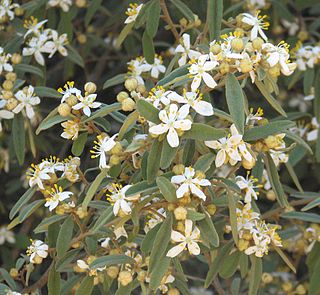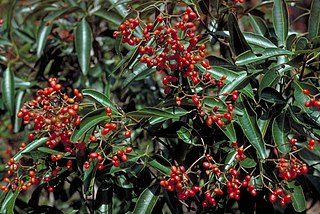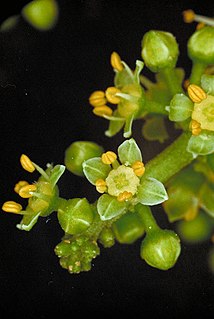
Boronia is a genus of about 160 species of flowering plants in the citrus family Rutaceae. Most are endemic to Australia with a few species in New Caledonia, which were previously placed in the genus Boronella. They occur in all Australian states but the genus is under review and a number of species are yet to be described or have the description published. Boronias are similar to familiar plants in the genera Zieria, Eriostemon and Correa but can be distinguished from them by the number of petals or stamens. Some species have a distinctive fragrance and are popular garden plants.

Flindersia is a genus of 17 species of small to large trees in the family Rutaceae. They have simple or pinnate leaves, flowers arranged in panicles at or near the ends of branchlets and fruit that is a woody capsule containing winged seeds. They grow naturally in Australia, the Moluccas, New Guinea and New Caledonia.

Bosistoa is a genus of four species of tree in the family Rutaceae endemic to eastern Australia. They have simple or compound leaves arranged in opposite pairs and bisexual flowers arranged in panicles, each flower with five sepals, five white petals and ten stamens.

Geijera is a genus of shrubs and trees in the family Rutaceae and are native to New Guinea, Australia and New Caledonia. They have simple leaves arranged alternately, panicles of bisexual flowers usually with five, sometimes four, sepals, petals and stamens and fruit containing shiny black seeds.

Asterolasia is a genus of seventeen species of erect or prostrate shrubs in the family Rutaceae, and is endemic to Australia. The leaves are simple and arranged alternately, the flowers arranged in umbel-like groups on the ends of branchlets or in leaf axils, usually with five sepals, five petals and ten to twenty-five stamens. There are seventeen species and they are found in all Australian mainland states but not in the Northern Territory.

Medicosma is a genus of shrubs and trees in the family Rutaceae, all native to New Guinea, Australia or New Caledonia. They usually have simple leaves arranged in opposite pairs, flowers arranged in cymes with four sepals, four petals and eight stamens. The fruit is a follicle fused at the base in groups of up to four, each containing one or two brown or black seeds.

Acradenia is a genus of two species of tree or shrub in the family Rutaceae and is endemic to Australia. These plants have leaves that are trifoliate, arranged in opposite pairs and flowers that have five sepals, five petals and usually ten stamens of unequal lengths.

Melicope elleryana, commonly known as pink flowered doughwood, pink evodia, corkwood, or saruwa, is a species of rainforest shrub or tree in the family Rutaceae, and is native to New Guinea, parts of eastern Indonesia, the Solomon Islands and northern Australia. It has trifoliate leaves and pink to white, bisexual flowers arranged in panicles in leaf axils.

Acronychia octandra, commonly known as doughwood, silver birch or soapwood, is a species of rainforest tree that is endemic to eastern coastal areas of Australia. It has mostly trifoliate leaves with elliptic to egg-shaped leaflets, greenish-white flowers arranged in groups in leaf axils and fleshy fruit of four carpels fused at the base.
Melicope contermina is a species of shrub or small tree in the family Rutaceae and is endemic to Lord Howe Island. It has trifoliate leaves and white flowers borne in leaf axils in panicles of nine to fifteen flowers.

Bouchardatia neurococca, commonly known as union nut, is a species of small rainforest tree that is endemic to eastern Australia. It has pinnate leaves with three or five narrow elliptical leaflets, white flowers arranged in panicles, and oval follicles.

Dinosperma is a genus of plant containing the single species Dinosperma erythrococcum, commonly known as tingletongue, clubwood or nutmeg, and is endemic to north-eastern Australia. It is a tree usually with trifoliate leaves arranged in opposite pairs, the leaflets lance-shaped to oblong, and panicles of small white flowers, later bright orange to red, slightly fleshy follicles containing shiny, bluish black seeds.
Melicope affinis is a species of shrub or tree in the family Rutaceae and is endemic to Queensland. It has trifoliate leaves and small greenish white flowers borne in panicles in leaf axils.

Melicope broadbentiana, commonly known as false euodia, is a species of shrub or tree in the family Rutaceae and is endemic to Queensland. It has simple leaves, trifoliate leaves or both, and small white flowers borne in short panicles in leaf axils.
Melicope fellii is a species of tree in the family Rutaceae and is endemic to Queensland. It has trifoliate leaves and pink flowers borne in short panicles in leaf axils.
Melicope hayesii, commonly known as small-leaved doughwood, is a species of shrub or slender tree in the family Rutaceae and is endemic to eastern Australia. It has trifoliate leaves and small white flowers borne in panicles in leaf axils.

Melicope jonesii is a species of tree in the family Rutaceae and is endemic to north-east Queensland. It has trifoliate leaves and greenish or cream-coloured flowers borne in short panicles in leaf axils.
Melicope peninsularis is a species of small tree in the family Rutaceae and is endemic to tropical north Queensland. It has trifoliate leaves and white flowers borne in short panicles in leaf axils.

Melicope rubra, commonly known as the little evodia, is a species of small tree in the family Rutaceae, and is endemic to north-east Queensland. It has trifoliate leaves and pink bisexual flowers arranged on branches below the leaves.

Melicope xanthoxyloides is a species of small tree in the family Rutaceae and is native to New Guinea and Queensland. It has trifoliate leaves and small green to yellow or cream-coloured flowers arranged in panicles in leaf axils.















